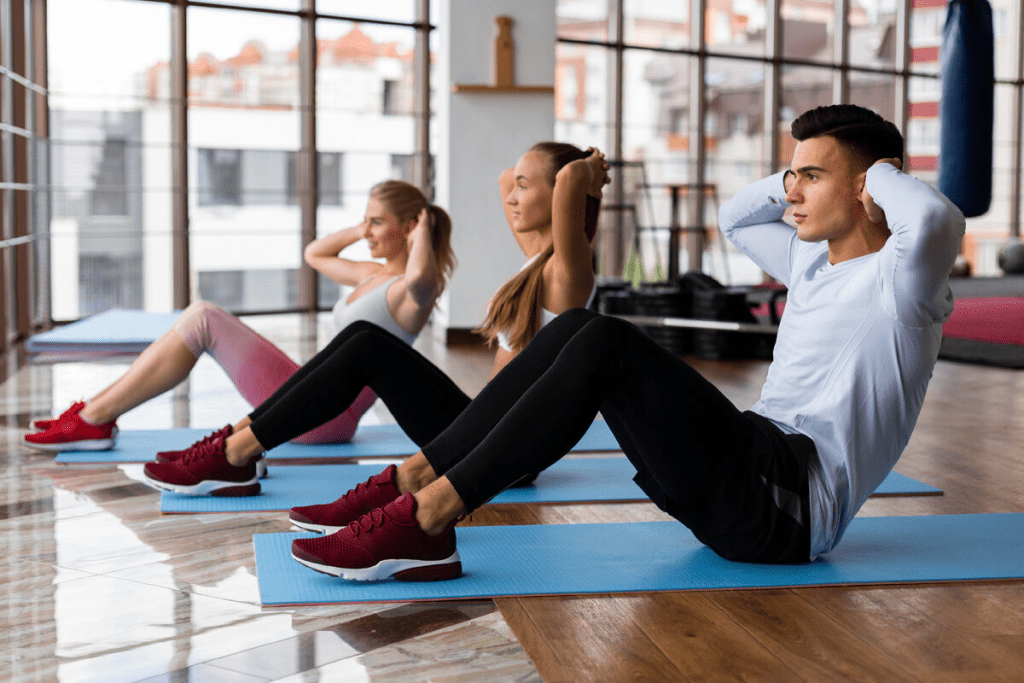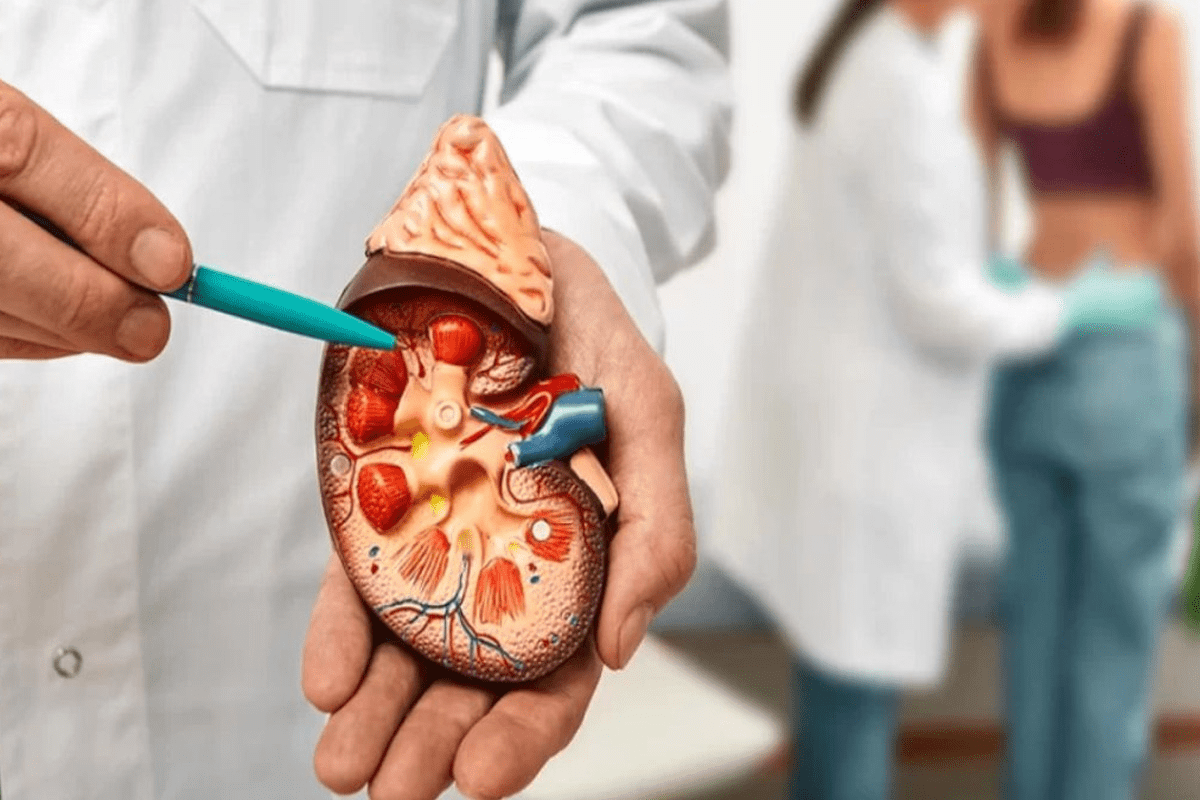Last Updated on November 26, 2025 by Bilal Hasdemir

Regular physical activity has many health benefits. Exercise can ease symptoms of prostate problems. Studies show that active men might face less risk of prostate issues.
Key Takeaways
- Regular exercise is associated with improved prostate health.
- Physical activity can alleviate symptoms of prostate issues.
- A healthy lifestyle includes regular exercise.
The Prostate Gland:
The prostate gland is a key part of a man’s body. It’s linked to many health problems that can affect how well a man lives. We’ll look at what it does and the common issues men face.
Anatomy and Role of the Prostate
The prostate gland is about the size of a walnut. It’s found below the bladder and in front of the rectum. It wraps around the urethra, the tube urine flows through. The prostate is important for the male reproductive system. It makes seminal fluid. This fluid helps and protects sperm when a man ejaculates.
Prevalent Prostate Conditions in American Men

Many American men deal with prostate health problems. The main issues are prostatitis, benign prostatic hyperplasia (BPH), and prostate cancer.
Here’s a closer look at these conditions:
- Prostatitis: This is when the prostate gets inflamed. It can cause pain and trouble with urination.
- Benign Prostatic Hyperplasia (BPH): This is when the prostate gets bigger but isn’t cancerous. It can make it hard to pee.
- Prostate Cancer: This is a tumor in the prostate that can grow slowly or quickly.
| Condition | Description | Common Symptoms |
| Prostatitis | Inflammation of the prostate | Painful urination, frequent urination |
| Benign Prostatic Hyperplasia (BPH) | Non-cancerous enlargement of the prostate | Difficulty starting urination, weak urine flow |
| Prostate Cancer | Malignant tumor in the prostate | Often asymptomatic in early stages, later symptoms include difficulty urinating |
Exercise Prostate Health:
Recent studies have shown a strong link between exercise and prostate health. It’s clear that physical activity is key to keeping men healthy. Exercise prostate health in many ways.
Research Evidence Supporting Physical Activity
Many studies have looked into how exercise impacts prostate health. They found that regular exercise can lower the risk of prostate cancer. It also helps manage symptoms of benign prostatic hyperplasia (BPH). Exercise boosts immune function, improves blood flow, and reduces inflammation. These benefits are great for a healthy prostate.
Hormonal and Inflammatory Mechanisms
Exercise changes hormone levels and reduces inflammation, both important for prostate health. It affects testosterone and estrogen levels, which are vital for prostate health. Regular exercise also lowers inflammation, a risk factor for prostate issues. Understanding these effects shows how exercise helps prostate health. It’s a complex but positive impact on men’s health.
Exercise for Prostate Cancer Prevention
Recent studies show that exercise might help lower the risk of prostate cancer. It’s clear that physical activity is good for our health. It might also help prevent prostate cancer.
Epidemiological Studies and Risk Reduction
Many studies have looked into how exercise affects prostate cancer risk. They found that active men have a lower risk of prostate cancer than inactive ones. It seems that exercise can help, but we’re not sure how yet. A study published in a leading oncology journal found that vigorous exercise lowers prostate cancer risk. It showed that regular, intense physical activity is key to reducing risk.
“Physical activity is a modifiable risk factor that can be targeted for prostate cancer prevention. Our findings support the hypothesis that vigorous physical activity is associated with a reduced risk of prostate cancer.”
Exercise Intensity and Frequency Recommendations
Experts are studying the best exercise levels and how often to do them for prostate cancer prevention. Current advice is to do at least 150 minutes of moderate or 75 minutes of vigorous aerobic activity weekly. Adding muscle-strengthening activities two or more times a week is also suggested.
- Moderate-intensity exercise: brisk walking, cycling, or swimming
- Vigorous-intensity exercise: running, jumping rope, or boxing
- Muscle-strengthening activities: weight training or bodyweight exercises
Talking to a healthcare professional is a good idea to create a workout plan that fits your health and goals.
How Exercise Can Reduce Prostate Enlargement

Men with prostate enlargement can find relief through exercise. Benign Prostatic Hyperplasia (BPH) is common in older men. It makes the prostate gland grow, causing urinary discomfort.
BPH Symptoms and Exercise Benefits
BPH symptoms can really affect a man’s life. They include weak urine flow, needing to urinate often, and waking up at night to pee. Exercise can help by improving prostate health and lessening BPH symptoms.
Regular exercise offers many benefits:
- It improves urinary function.
- It reduces inflammation.
- It boosts overall well-being.
Men with BPH can reduce symptoms and live better by exercising regularly.
Specific Activities That Help Manage Enlargement
Some exercises are better for BPH symptoms. These include:
- Aerobic exercises like brisk walking, cycling, or swimming. They improve heart health and reduce inflammation.
- Pelvic floor exercises (Kegels) strengthen muscles around the prostate. They help with urinary control.
- Yoga and stretching improve flexibility and lower stress.
Adding these activities to your routine can help manage BPH symptoms well.
It’s wise to talk to a doctor before starting any new exercise. This is true for men with health issues. Exercise can be a key part of managing prostate health and reducing BPH symptoms.
Aerobic Exercise and Prostate Health Benefits
Aerobic exercise is good for prostate health. It’s key for overall health and helps the prostate work better. We’ll see how it helps prostate health and the best cardio activities for it.
Optimal Cardio Activities for Prostate Function
Doing aerobic exercise is vital for a healthy prostate. Brisk walking, cycling, and swimming are great choices. They boost heart health and help the prostate too.
Some benefits of aerobic exercise for prostate health are:
- Lowering prostate cancer risk
- Improving prostate function
- Boosting heart health
Good cardio activities for prostate health are:
- Brisk walking
- Cycling
- Swimming
- Jogging or running
Adding these activities to your routine helps keep the prostate healthy. It’s important to pick exercises you like and can stick with.
Strength Training for Prostate Protection
Adding strength training to your workout can really help your prostate health. Studies show that it can lower the risk of prostate problems. It also boosts your overall health and life quality.
Key Exercises for Prostate Health
To get the most from strength training for your prostate, choose exercises that work many muscles at once. Some great ones are:
- Squats: They strengthen your legs and glutes and also work your core.
- Deadlifts: These exercises target your back, legs, and glutes.
- Bench Press: It works your chest, shoulders, and triceps.
- Rows: They engage your back, shoulders, and arms.
- Leg Press: This strengthens your legs and glutes.
Hormonal Balance and Muscle Building
Resistance training helps balance your hormones, which is key for prostate health. It can increase testosterone, improve insulin sensitivity, and balance your hormones better. Regular exercise, including strength training, is vital for your health. It helps lower the risk of prostate issues.
Yoga for Prostate Health: Poses and Practices
Yoga is an ancient practice that combines physical postures, breathing techniques, and meditation. It promotes overall well-being. Recent studies show its benefits for prostate health, making it a valuable addition to traditional treatments. We will explore how yoga supports prostate health and discuss beneficial poses and practices.
Beneficial Yoga Positions
Certain yoga poses are great for prostate health. They improve blood flow, reduce stress, and promote well-being. Cobra Pose, Warrior Pose, and Tree Pose are among the most beneficial.
| Yoga Pose | Benefit |
| Cobra Pose | Strengthens back muscles, improves circulation |
| Warrior Pose | Enhances balance, reduces stress |
| Tree Pose | Improves balance, reduces anxiety |
Meditation and Stress Reduction Effects
Meditation is a powerful tool for reducing stress and anxiety. These factors can negatively impact prostate health. Regular meditation practice has been shown to reduce prostate symptoms, improve well-being, and enhance healing. By adding meditation to their daily routine, individuals can lower their risk of prostate problems. Start with short, guided meditation sessions. Gradually increase the duration as you get more comfortable with it.
Best Exercise Routines for Prostate Gland Health
Exercising regularly is key for a healthy prostate gland. It boosts overall health and helps keep the prostate in check. A good exercise plan can lower the risk of prostate problems and make life better.
Comprehensive Weekly Exercise Plans
Having a weekly plan with different activities keeps things fun and stops boredom. Mix aerobic exercises, strength training, and flexibility to stay fit and healthy.
Aerobic Exercises: Walking fast, cycling, or swimming for 150 minutes a week is great for the heart and prostate.
Strength Training: Doing resistance exercises two times a week builds muscle and helps balance hormones, which is good for the prostate.
“Exercise is a cornerstone of health, and when done correctly, it can significantly reduce the risk of prostate issues.” –
A renowned health expert
- Aerobic exercises: 150 minutes/week
- Strength training: 2 days/week
- Flexibility exercises: 2-3 days/week
Following this plan helps keep the prostate gland healthy and improves overall health.
Can Regular Exercise Lower PSA Levels?
Research suggests that exercise may help manage PSA levels. Prostate-Specific Antigen (PSA) is a protein from the prostate gland. High levels can mean prostate problems, like cancer. Knowing how exercise affects PSA levels is key for men to keep their prostate healthy.
Research on Physical Activity and PSA Measurements
Studies have looked into how exercise and PSA levels are connected. A study in the Journal of Urology found that active men had lower PSA levels than inactive ones. The exact reasons are not clear, but exercise might lower PSA by reducing inflammation and improving hormone balance.
“Physical activity is associated with reduced inflammation and improved immune function, which may contribute to lower PSA levels.”
Research shows mixed results on exercise and PSA levels. Some studies found a strong link, while others did not. The type and amount of exercise might affect these results.
Exercise Timing Before PSA Testing
When to exercise before PSA testing is important. Vigorous exercise can change PSA levels, leading to wrong test results. A study advised waiting at least 24 hours after intense exercise before getting a PSA test.
| Exercise Timing | Potential Impact on PSA Levels | Recommendation |
| Within 24 hours of PSA testing | Possible temporary increase or fluctuation | Delay PSA testing by at least 24 hours |
| Regular, long-term exercise | Potential long-term reduction | Maintain consistent exercise routine |
In summary, while the science is not complete, regular exercise likely helps PSA levels. Men should talk to their doctors about their exercise and testing plans.
Walking and Prostate Health Benefits
Walking is a simple yet effective way to improve prostate health. It’s important to understand how this low-impact exercise can contribute to overall well-being, focusing on men’s health.
How Daily Walking Improves Prostate Function
Daily walking can significantly improve prostate function by boosting blood circulation and reducing inflammation. Regular physical activity, like walking, supports overall prostate health. We recommend adding a daily walking routine to your lifestyle to possibly lower the risk of prostate issues. Walking is an accessible exercise that suits various fitness levels. It’s perfect for men wanting to boost their prostate health.
Step Count Goals for Optimal Benefits
Setting a daily step count goal can maximize walking’s benefits for prostate health. Studies show that 7,000 to 8,000 steps a day can improve heart health and lower chronic disease risk.
- Start with a manageable goal, such as 5,000 steps per day, and gradually increase your target.
- Incorporate walking into your daily routine, such as walking to work or taking a walk during your lunch break.
- Use a pedometer or fitness tracker to track your progress and stay motivated.
By adding daily walking to your routine and aiming for optimal step count goals, you can support your prostate health proactively.
Running and Prostate Health: Finding the Balance
The link between running and prostate health is complex. It involves many factors that affect our overall health. We need to look at both the good and bad sides of running, mainly for men with prostate issues.
Benefits of Different Running Intensities
Running can be adjusted to fit different levels of intensity. Each level has its own benefits for prostate health. Moderate running boosts heart health, which helps prostate health by improving blood flow and reducing swelling.
- Low-Intensity Running: This is easy on the body. It’s great for older men or those with health issues. It helps blood flow and can lower stress.
- High-Intensity Running: This type of running improves heart health and strengthens the immune system. But, it’s important to balance hard runs with rest to avoid too much strain.
Studies show that running intensity affects prostate health. For example, a study found that men who ran hard had a lower risk of prostate cancer than those who didn’t exercise as much.
“Exercise is a key part of a healthy life, and running can be very good for prostate health if done right.”
” A Urologist
Precautions for Men with Existing Conditions
Running is good, but men with prostate issues need to be careful. Always talk to a doctor before starting or changing your running routine, even more so if you have conditions like prostatitis or BPH.
- Consult a Healthcare Provider: Always talk to your doctor before starting a new exercise plan to make sure it’s safe for you.
- Monitor Your Body: Listen to how your body feels after running. If you notice pain, discomfort, or trouble urinating, change your routine.
- Stay Hydrated: Drinking enough water is key, even more so when you’re running. It helps keep your prostate and overall health in check.
By knowing the benefits and taking the right steps, men can enjoy running while keeping their prostate healthy. It’s about finding a balance that fits your health needs.
Cycling Prostate Health Effects: Myths and Facts
The link between cycling and prostate health is a topic of debate. Cycling is known for its heart health benefits and is low-impact. Yet, some worry about its effects on the prostate. Cycling puts pressure on the perineum, the area between the scrotum and anus. This pressure might harm prostate health, leading to prostatitis or worsening existing conditions.
Research on Saddle Pressure and Prostate Health
Research has looked into how saddle pressure affects prostate health. Some studies suggest cycling, on poorly designed saddles, might raise prostate risks. The pressure could cause numbness, discomfort, and affect prostate health. But, the evidence isn’t clear-cut. Many studies say cycling’s heart health and obesity reduction benefits might outweigh the risks.
Equipment Modifications for Safer Cycling
Men worried about cycling’s prostate effects can take steps to reduce risks. Using a well-fitted saddle that eases perineum pressure is key. Standing up often and adjusting the bike for comfort also helps. Wearing padded shorts and taking breaks during long rides can lessen discomfort. Some cyclists use saddles with cutouts to reduce pressure on sensitive spots. In summary, while cycling and prostate health concerns are valid, the right equipment and riding habits can minimize risks. It’s important to listen to your body and seek medical advice if needed.
Exercise After Prostate Surgery: Recovery Guidelines
The time after prostate surgery is key. A good exercise plan can help you recover well. It’s important to remember that everyone’s recovery is different. Your exercise plan should match your recovery stage.
Phased Return to Physical Activity
Getting back to physical activity after surgery takes time. Start with easy movements that help blood flow. Avoid putting too much pressure on the surgery area. As you get better, you can do more intense exercises.
We suggest the following steps:
- Immediate Post-Surgery (0-2 weeks): Gentle stretching and short walks.
- Early Recovery (2-6 weeks): Progressive walking and light aerobic exercises.
- Late Recovery (6-12 weeks): Introduction to strength training and more intense aerobic activities.
Recommended Exercises by Recovery Stage
Each recovery stage needs specific exercises. Here’s a guide:
| Recovery Stage | Recommended Exercises | Benefits |
| Immediate Post-Surgery | Short walks, deep breathing exercises | Improves circulation, reduces risk of blood clots |
| Early Recovery | Brisk walking, pelvic tilts | Enhances cardiovascular health, strengthens pelvic muscles |
| Late Recovery | Strength training (light weights), swimming | Builds muscle, improves overall fitness without straining the prostate area |
Always listen to your body and don’t rush. It’s important to talk to your doctor before starting any new exercise. By following these guidelines and adjusting your exercise to your recovery, you can heal better. This will also help improve your prostate health.
Prostate Exercise:
Science shows a strong link between pelvic floor exercises and better prostate health. Pelvic floor training, or Kegel exercises, is key for prostate health and overall urinary and sexual function.
Proper Kegel Exercise Technique
To do Kegel exercises right, first find your pelvic floor muscles. These muscles help stop urine flow or gas. It’s important to contract these muscles without using your abdomen, thighs, or buttocks. Here’s how to do it:
- Start by emptying your bladder.
- Sit or lie down comfortably.
- Tighten your pelvic floor muscles, holding for 5 seconds.
- Release the contraction for 5 seconds.
- Repeat this process 10-15 times per session.
- Aim for 3 sessions a day.
Benefits for Urinary Control and Sexual Function
Kegel exercises strengthen pelvic floor muscles, improving urinary control and sexual function. Improved urinary control means fewer incontinence episodes, better quality of life. For sexual function, stronger muscles can lead to better erections and more intense orgasms. Studies show regular Kegel exercises can improve these areas. This helps with overall prostate health and well-being. Adding pelvic floor training to your daily routine supports prostate health. It also boosts urinary control and sexual function. We suggest making Kegel exercises a regular part of your health routine.
Lifestyle Changes That Enhance Exercise Benefits
Regular exercise is just the start. Making lifestyle changes can also boost prostate health. These changes work together with exercise to improve overall health and lower prostate risks.
Dietary Considerations for Prostate Health
Eating right is key for a healthy prostate. Focus on fruits, veggies, and healthy fats. Antioxidants like lycopene in tomatoes and omega-3s in fish are great for your prostate. Try to cut down on processed meats and saturated fats. A balanced diet boosts the benefits of exercise for your prostate.
Sleep, Stress Management, and Hydration
Good sleep, stress control, and staying hydrated are vital for prostate health. Bad sleep and stress can mess with hormone levels, harming your prostate. Try stress-reducing activities like meditation or yoga. Drinking enough water is also key for your prostate’s health.
Supplements and Their Evidence Base
While a good diet is essential, some supplements can help too. Saw palmetto, zinc, and vitamin D might offer benefits. But always talk to a doctor before taking supplements.
| Lifestyle Change | Benefit for Prostate Health |
| Healthy Diet | Provides essential nutrients and antioxidants |
| Adequate Sleep | Supports hormonal balance |
| Stress Management | Reduces negative impact on hormonal balance |
| Proper Hydration | Supports overall health, including prostate |
| Supplements | May offer additional benefits when used appropriately |
By adding these lifestyle changes to regular exercise, men can support their prostate health better.
Conclusion:
Regular exercise is key to keeping your prostate healthy. Adding physical activity to your day can lower the risk of prostate problems. It also boosts your overall health. To keep your prostate healthy for life, create a workout plan that includes cardio, strength training, and stretching. Aim for 150 minutes of moderate exercise or 75 minutes of intense exercise each week. Also, make sure to do strength training regularly. Healthy habits like regular exercise, a balanced diet, and managing stress are important for a healthy prostate. By making these habits part of your life, you’ll enjoy the benefits of a good workout routine. This helps keep your prostate healthy for years to come.
FAQ
Can exercise really improve prostate health?
Yes, regular exercise is good for the prostate. It can lower the risk of prostate problems. It also helps with symptoms of conditions like BPH and boosts overall health.
What types of exercise are best for prostate health?
Aerobic exercises like walking, running, and cycling are great. Strength training and flexibility exercises, like yoga, are also beneficial.
How often should I exercise to support prostate health?
Aim for 150 minutes of moderate aerobic activity weekly. Or do 75 minutes of vigorous activity. Also, do strength training on two or more days a week.
Can exercise help prevent prostate cancer?
Research shows that exercise might lower prostate cancer risk. But, scientists are studying how it works.
How does cycling affect prostate health?
Cycling is good for your heart but can put pressure on the prostate. Use a well-fitting saddle and take breaks to avoid this.
Are Kegel exercises beneficial for prostate health?
Yes, Kegel exercises strengthen pelvic muscles. They improve urinary control and sexual function, which is good after prostate surgery.
Can exercise lower PSA levels?
Some studies say exercise might lower PSA levels. But, more research is needed to understand the timing of exercise and PSA testing.
What lifestyle changes can enhance the benefits of exercise for prostate health?
Eating well, sleeping enough, managing stress, staying hydrated, and using supplements can help. These habits support prostate health along with exercise.
How soon can I resume exercise after prostate surgery?
Recovery time varies after prostate surgery. Start with gentle exercises and gradually increase intensity as you get stronger.
Can yoga help with prostate health?
Yes, yoga can improve pelvic health and reduce stress. These benefits are good for prostate health.
Is walking beneficial for prostate health?
Walking is excellent for prostate health. Try to walk at least 7,000 to 8,000 steps a day.
How does strength training impact prostate health?
Strength training helps balance hormones and builds muscle. Both are good for prostate health.
References
- Jain, M. A. (2023). Prostate Cancer Screening. StatPearls Publishing. https://www.ncbi.nlm.nih.gov/books/NBK556081/






